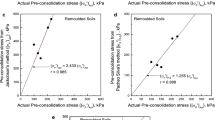Abstract
Conventional laboratory consolidation tests usually take weeks to conduct, depending on the field loading conditions. While centrifuge consolidation has been proven to shorten this period significantly, no attempt has been made to introduce this method to the professional community because the centrifuges are very large and are, for the most part, utilized only by scientists. The aim of this investigation is to illustrate the feasibility of using the centrifuge consolidation test as a practical tool to estimate the consolidation behavior of natural soils by employing a miniature centrifuge apparatus. Thirty-two soil samples were subjected to 1-D conventional and centrifuge consolidation tests. An empirical relationship was established between the two different consolidation techniques to predict the consolidation behavior. The consolidation curves of the 32 soil samples computationally-obtained from the centrifuge method were in good agreement with those obtained by the conventional method, hence it is possible to determine the recompression and compression indices with reasonable accuracy. The only practical limitation with the proposed apparatus is the determination of the consolidation coefficient; this part of the research remains in progress.
Résumé
Les essais conventionnels oedométriques de laboratoire demandent des semaines pour leur réalisation, suivant les conditions de chargement à reproduire. Alors qu’il est prouvé que la consolidation des sols par centrifugation permet de raccourcir le temps d’essai de façon significative, aucune tentative pour introduire cette technique dans le milieu professionnel n’a été faite car les centrifugeuses sont de gros appareils et sont, pour la plupart, utilisées uniquement par les scientifiques. Le but de cette recherche est d’illustrer la faisabilité d’un essai de consolidation, avec une centrifugeuse miniature, pour estimer la compressibilité des sols. Trente-deux sols ont été soumis à l’essai oedométrique conventionnel et au test de consolidation à la centrifugeuse. Des relations empiriques ont été établies entre les résultats de ces deux essais. Les courbes de consolidation des 32 sols, dérivées par calcul de l’essai à la centrifugeuse, étaient en bon accord avec celles obtenues par la méthode conventionnelle, permettant ainsi de déterminer les indices de recompression et de compression avec une précision raisonnable. La seule limitation pratique, avec l’appareil proposé, est la détermination des coefficients de consolidation, cet aspect de la question faisant encore l’objet de recherches.








Similar content being viewed by others
References
Al-Hussaini MM, Goodings DJ, Schofield AN, Townsend FC (1981) Centrifuge modeling of coal waste embankments. J Geotech Eng Div ASCE 107(GT4):481–499
American Standards for Testing Materials (2003) Standard test methods for one-dimensional consolidation properties of soils using incremental loading. ASTM D2435-03, West Conshohocken, PA
Arulandanan K, Thompson PY, Kutter BL, Meegoda NJ, Muraleetharan KK, Yogachandran C (1988) Centrifuge modeling of transport processes for pollutant in soils. J Geotech Eng ASCE 114(2):185–205
Butterfield R (2000) Scale-modeling of fluid flow in geotechnical centrifuges. Soils Found 40(6):39–45
Cargill KW, Ko HY (1983) Centrifuge modeling of transient water flow. J Geotech Eng ASCE 102(2):366–387
Croce P, Pane V, Znidarcic D, Ko H-Y, Olsen HW, Schiffman RL (1984) Evaluation of consolidation theories by centrifuge modelling. In: Proceedings of the international conference on applications of centrifuge modelling to geotechnical design, Manchester University, UK, pp 380–401
Fox PJ, Lee J, Qui T (2005) Model for large strain consolidation by centrifuge. Int J Geomech 5(4):267–275
Goodings DJ (1979) Centrifuge modeling of slope failures. Thesis presented to University of Cambridge, p 287
Holtz RD, Kovacs WD (1981) An introduction to geotechnical engineering. Prentice Hall, NJ, p 733
Kimura T, Kusakabe O, Takemura J, Saitoh K (1984) Preparation of a normally consolidated clay stratum in a centrifuge. Soils Found 24(4):71–83
Moo-Young H, Myers T, Tardy B, Ledbetter R, Vanadit-Ellis W, Kim T-H (2003) Centrifuge simulation of the consolidation characteristics of capped marine sediment beds. Eng Geol 70:249–258
Muir Wood D (2004) Geotechnical modeling. Spon Press, London, p 498
Ng CW, Kutter BL (2001) Proceeding of international symposium on geotechnical centrifuge modeling and networking—focusing on the use and application in the Pan-Pacific region: December 8–9, 2001, Hong Kong University of Science and Technology
Robinson RG, Tan TS, Lee FH (2003) A comparative study of suction-induced seepage consolidation versus centrifuge consolidation. Geotech Test J 26(1):1–10
Singh DN, Gupta KA (2000) Modeling hydraulic conductivity in a small centrifuge. Can Geotech J 37(5):1150–1155
Singh DN, Kuriyan SJ (2002) Estimation of hydraulic conductivity of unsaturated soils using a geotechnical centrifuge. Can Geotech J 39:684–694
Springman S, Bolton M, Sharma J, Balachandran S (1992) Modeling and instrumentation of a geotextile in the geotechnical centrifuge. In: Ochiai H, Hayashi S, Otani J (eds) Earth reinforcement practice. Balkema, Rotterdam
Takada N, Mikasa M (1986) Determination of consolidation parameters by selfweight consolidation test in centrifuge. In: Yong RN, Townsend FC (eds) Consolidation of soils—testing and evaluation, ASTM STP 892. American Society of Testing and Materials, Philadelphia, pp 548–566
Acknowledgments
This research was funded by Grant No. 09B4343015 from the University of Ankara.
Author information
Authors and Affiliations
Corresponding author
Rights and permissions
About this article
Cite this article
Kayabali, K., Ozdemir, A. Assessing the practicality of the centrifuge method for 1-D consolidation. Bull Eng Geol Environ 71, 735–745 (2012). https://doi.org/10.1007/s10064-012-0426-7
Received:
Accepted:
Published:
Issue Date:
DOI: https://doi.org/10.1007/s10064-012-0426-7




